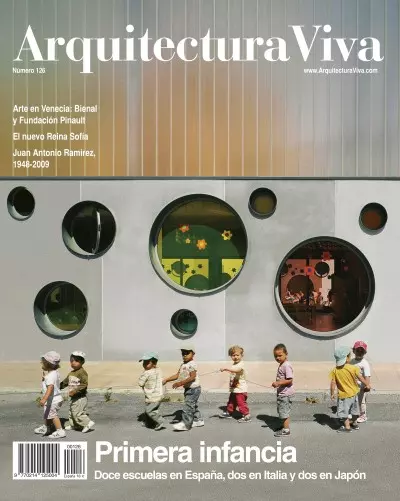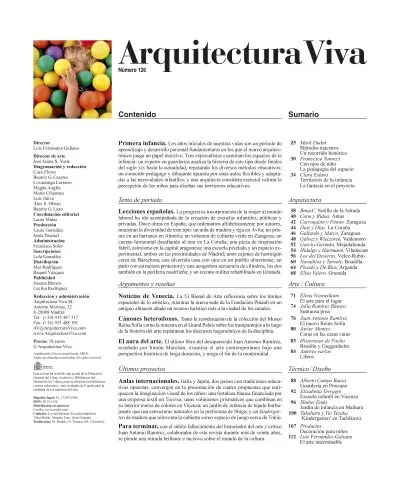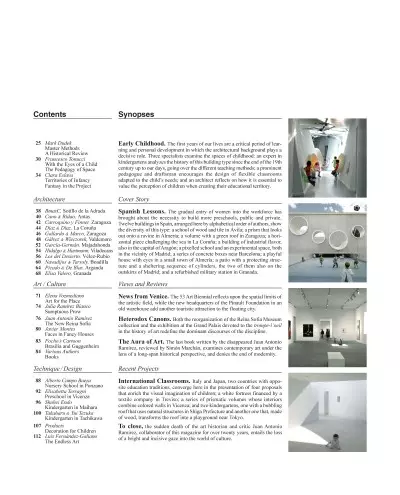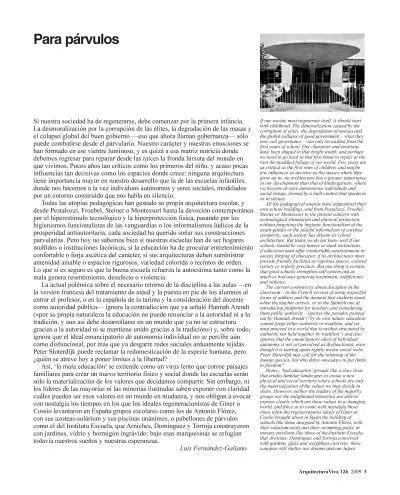Synopses
Early?Childhood. The first years of our lives are a critical period of learning and personal development in which the architectural background plays a decisive role. Three specialists examine the spaces of childhood: an expert in kindergartens analyzes the history of this building type since the end of the 19th century up to our days, going over the different teaching methods; a prominent pedagogue and draftsman encourages the design of flexible classrooms adapted to the child’s needs; and an architect reflects on how it is essential to value the perception of children when creating their educational territory.
Contents
Mark Dudek
Master Methods
A Historical Review
Francesco Tonucci
With the Eyes of a Child
The Pedagogy of Space
Clara Eslava
Territories of Infancy
Fantasy in the Project
Spanish Lessons. The gradual entry of women into the workforce has brought about the necessity to build more preschools, public and private. Twelve buildings in Spain, arranged here by alphabetical order of authors, show the diversity of this type: a school of wood and tile in Ávila; a prism that looks out onto a ravine in Almería; a volume with a green roof in?Zaragoza; a horizontal piece challenging the sea in?La Coruña; a building of industrial flavor, also in the capital of Aragón; a pixelled school and an experimental space, both in the vicinity of Madrid;?a series of concrete boxes near Barcelona; a playful house with eyes in a small town of Almería; a patio with a protecting struc-ture and a sheltering sequence of cylinders, the two of them also on the outskirts of Madrid; and a refurbished military station in Granada.
BmasC, Sotillo de la Adrada
Cano & Ridao, Antas
Carroquino y Finner, Zaragoza
Díaz & Díaz, La Coruña
Gallardo & Marco, Zaragoza
Gálvez & Wieczorek, Valdemoro
García-Germán, Majadahonda
Hidalgo & Hartmann, Viladecans
Los del Desierto, Vélez-Rubio
Navadijos & Tarsoly, Boadilla
Picado & De Blas, Arganda
Elisa Valero, Granada
Views and Reviews
News from Venice. The 53 Art Biennial reflects upon the spatial limits of the artistic field, while the new headquarters of the Pinault Foundation in an old warehouse add another touristic attraction to the floating city.
Art / Culture
Elena Vozmediano
Art for the Place
Julia Ramírez Blanco
Sumptuous Prow
Heterodox Canons. Both the reorganization of the Reina Sofía Museum collection and the exhibition at the Grand Palais devoted to the trompe-l’oeil in the history of art redefine the dominant discourses of the discipline.
Juan Antonio Ramírez
The New Reina Sofía
Javier Montes
Faces in Fancy Houses
The Aura of Art. The last book written by the disappeared Juan Antonio?Ramírez, reviewed by Simón?Marchán, examines contemporary art under the lens of a long-span historical perspective, and denies the end of modernity.
Focho’s Cartoon
Brasilia and Guggenheim
Various Authors
BooksRecent Projects
International Classrooms. Italy and Japan, two countries with oppo-site education traditions, converge here in the presentation of four proposals that enrich the visual imagination of children; a white fortress financed by a textile company in Treviso; a series of prismatic volumes whose interiors combine colored walls in?Vicenza; and two kindergartens, one with a bubbling roof that uses natural structures in Shiga?Prefecture and another one that, made of wood, transforms the roof into a playground near Tokyo.
Technique / Style
Alberto Campo Baeza
Nursery School in Ponzano
Elisabetta Terragni
Preschool in Vicenza
Shuhei Endo
Kindergarten in Maihara
Takaharu & Yui Tezuka
Kindergarten in Tachikawa
To close, the sudden death of the art historian and critic Juan Antonio? Ramírez, collaborator of this magazine for over twenty years, entails the loss of a bright and incisive gaze into the world of culture.
Products
Decoration for Children
Luis Fernández-Galiano
The Endless Art
Luis Fernández-Galiano
For infants
If our society must regenerate itself, it should start with childhood. The demoralization caused by the corruption of elites, the degradation of masses and the global collapse of good government – what they now call governance – can only be tackled from the first years of school. Our character and emotions have been shaped in that bright womb, and perhaps we need to go back to that first home to repair at the root the muddled foliage of our world. Few years are as critical as the first ones of children, and maybe few influences as decisive as the spaces where they grow up in: no architecture has a greater importance in our development than that of kindergartens, where we become at once autonomous individuals and social beings, formed by a built context that speaks to us in silence.
All the pedagogical utopias have engendered their own school buildings, and from?Pestalozzi,?Froebel,?Steiner or Montessori to the present concern with technological stimulation and physical protection, without forgetting the hygienic functionalism of the avant-gardes or the playful informalism of carefree prosperity, each society has dreamt its school architecture. But today we do not know well if our schools should be cozy homes or stark institutions, if education must offer comfortable entertainment or ascetic forging of character, if its architectures must provide friendly facilities or rigorous spaces, colored variety or orderly precincts. But one thing is certain, that good schools strengthen self-esteem just as much as bad ones generate resentment, indifference and violence.
The current controversy about discipline in the classroom – in the French version of using respectful forms of address and the demand that students stand when the teacher arrives, or in the Spanish one of introducing platforms for teachers and considering them public authority – ignores the paradox pointed out by Hannah?Arendt (“by its own nature education cannot forgo either authority or tradition, and yet must proceed in a world that is neither structured by authority nor held together by tradition”) and also ignores that the emancipatory ideal of individual autonomy is not yet perceived as dysfunctional, even though it is tearing apart tightly woven social webs. Peter Sloterdijk may call for the retaming of the human species, but who dares nowadays to put limits to freedom??
Hence, ‘bad education’ spreads like a slow virus that erodes familiar landscapes to create a new physical and social territory where schools are only the materialization of the values we may decide to share. However, neither the leaders of the majority groups nor the enlightened minorities are able to express clearly which are these values in a changing world, and force us to evoke with nostalgia those times when the regenerationist ideals of Giner or Cossío brought about in?Spain the building of schools like those designed by Antonio?Flórez, with their solarium-roofs and their swimming pools, or nursery pavilions like those of the Instituto Escuela, that Arniches, Domínguez and?Torroja conceived with gardens, glass and weightless concrete: these canopies still shelter our dreams and our hopes.








